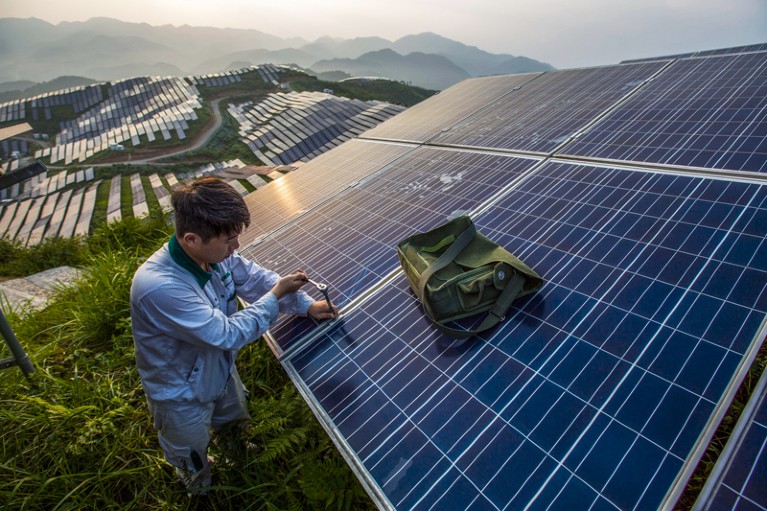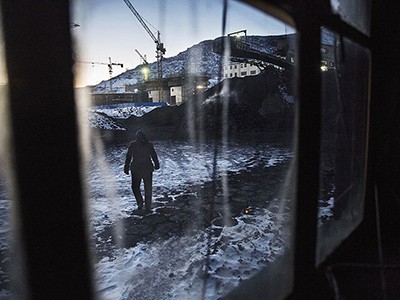
Renewable energy is booming but so is energy demand.Credit: Feature China/Barcroft Images/Getty
Countries will initiate the first formal review of progress under the 2015 Paris climate pact at the United Nations climate talks in Bonn, Germany, next week. According to the UN, the ‘Talanoa Dialogue’ aims to “share stories, build empathy and to make wise decisions for the collective good. The process of Talanoa involves the sharing of ideas, skills and experience through storytelling.”
Delegates will no doubt come to the table with countless tales of deployment of clean-energy technologies and initiatives to help communities to prepare for a warming world. But the process must prompt serious self-reflection from policymakers on how far they are falling short of their 2015 climate commitments — and what it will take for them to put the world on a track to real sustainability.
As we discuss in a News Feature this week, there is encouraging news. The nascent clean-energy industry has found its feet. Wind and solar sources are already used ahead of fossil fuels in many places, and renewables will become only more competitive as technology prices fall in the years to come. Indeed, at least one energy consultancy predicts that installing solar panels in 2030 will be a cheaper way of generating energy in some places than continuing to shovel coal into the furnaces of ageing power plants. Similarly, electric vehicles are likely to become cheaper to buy and run than petrol-powered incumbents over the next decade.
Can the world kick its fossil-fuel addiction fast enough?
These genuine tipping points could disrupt energy markets and potentially enable much faster change than anybody anticipates today. From this perspective, it is surely only a matter of time before clean-energy technologies come to dominate. But time is precisely what humanity does not have — not if it wants to meet the Paris goal of limiting warming to 1.5–2 °C above pre-industrial levels.
Renewables now capture the bulk of global investments in new power installations each year, covering much of the annual growth in energy demand. That leaves a lot of existing infrastructure that continues to burn oil, coal and gas — with the financial support of governments. Despite efforts to reduce fossil-fuel subsidies, a recent study found that governments still handed over some US$330 billion of subsidies in 2015 (J. Jewell et al. Nature 554, 229–233; 2018).
The consequences are clear. With nearly 1 °C of warming in the bag, the world is already experiencing unwanted effects, such as extreme weather events. These will continue to mount unless and until humanity slashes its greenhouse-gas emissions. A sober look at the numbers suggests that this task will be difficult — if not impossible — without radical interventions to deliberately steer energy producers and users towards sustainable options.
That takes political commitment, which will be one focus of next week’s dialogue. The news on this score is mixed at best. US President Donald Trump is promoting a retrograde energy agenda, and has vowed to pull the United States out of the Paris agreement. (Still, despite their rhetoric and ambitions, Trump and his allies have yet to halt coal’s probably inevitable decline in the face of cheap natural gas and renewables.)
Support for the Paris agreement remains high outside the United States, but has its limits. Estimates suggest that actions on emissions so far have probably shaved off 1 °C or so from the projected warming this century, but the world remains on course for a rise of well over 3 °C. That’s true even if countries fulfil their current emissions pledges, which isn’t likely.
Perhaps the best news is that developing countries — including China and India, plagued by air pollution in many urban areas — have come to view clean energy through the lens of public health and air quality. Policies on climate and sustainable development that promote clean, low-carbon energy go hand in hand.
Another way to measure progress is to look at where the money is going. Given the scale of the challenge ahead, the goal of policymakers must be to align investments across the climate landscape, from energy efficiency and carbon-free energy sources to green buildings, cities and other infrastructure.
Ultimately, human influence on the climate comes down to one thing: what volume of carbon dioxide and other greenhouse gases is pumped into the atmosphere. This means that ramping up renewables to meet energy demand simply isn’t enough. Reducing carbon emissions means making painful choices: halting new investments in the exploration and production of fossil fuels, and then closing down existing facilities. It won’t be easy, but eventually that is a story that must be told.

 Can the world kick its fossil-fuel addiction fast enough?
Can the world kick its fossil-fuel addiction fast enough?
 As climate talks end, it is time for action
As climate talks end, it is time for action
 Prove Paris was more than paper promises
Prove Paris was more than paper promises
 Fossil-fuel subsidies assessed
Fossil-fuel subsidies assessed





